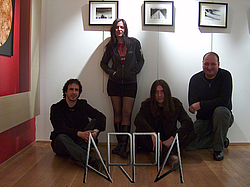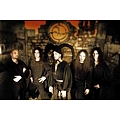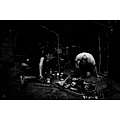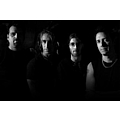Arpia Biography
Arpia nasce nel febbraio 1984 con la seguente formazione: Leonardo Bonetti - voce, basso, sinth; Fabio Brait - chitarra; Aldo Orazi - batteria. Già nell''85 Arpia cominciò a sperimentare nei concerti forme di contaminazione estetica coinvolgendo mimi e attori intorno ad un progetto che superasse gli schemi dello spettacolo musicale tradizionale per indirizzarsi a ricerche teatrali. Dopo due anni di lavoro in questa direzione, nel 1987 esce, quale realizzazione di tutta la prima fase compositiva, “de lesioni”, demo sperimentale ma ricco di forme e idee poi sviluppate in modo più organico in seguito. “Resurrezione e Metamorfosi”, composizione-fiume uscita nell''88, dalla durata di 40 minuti, è il lavoro che porta a conclusione tutta questa fase. Nei due anni seguenti, cioè quelli precedenti l'ultimo lavoro su cassetta, “Bianco Zero”, Arpia ha spostato la sua attenzione con sempre maggiore energia sugli aspetti più problematici e ricchi di conseguenze della realtà in cui ha preso definitivamente sangue: è questo il terreno su cui si impianta la produzione più recente. E in effetti l'evoluzione ultima del gruppo vede una rinnovata dimensione nel modo di strutturare gli spettacoli, che perdono quella misura genuinamente teatrale per indirizzarsi con più efficacia verso una tensione comunicativa; le sonorità cambiano considerevolmente con l'introduzione delle tastiere, e portano ai brani usciti su 7" nel settembre del 1992: “Ragazzo Rosso” e “Idolo e Crine”. Nell’aprile del 1995, questo percorso trova il suo sbocco naturale sia da un punto di vista artistico che discografico, con l'uscita del primo CD: Liberazione. Si tratta di un concept ideato intorno all'idea di un viaggio nella memoria storica del nostro paese a cinquant'anni, appunto, dalla liberazione dal nazifascismo. Non c'è, comunque, una volontà puramente politica, bensì l'esigenza di riappropriarsi di una storia collettiva attraverso storie individuali. In questi ultimi quattro anni, infine, l’evoluzione verso soluzioni ritmiche e sonorità più istintive e meno rarefatte porta ad un allargamento del gruppo con collaborazioni che vedono l’intervento di Paola Feraiorni alla voce e di Tonino De Sisinno alle percussioni. Al termine di questa fase, nel settembre del 2006, esce l’ultimo lavoro del gruppo dal titolo “Terramare” il cui nucleo può essere individuato nell’esperienza erotica del mondo. Terra e Mare, elementi di fisicità e sessualità, poli di una continuità reale e riconoscibile, orizzontali e appartenenti entrambi ad un gioco di contrasti comunemente accettati, in cui ogni elemento rispetta il suo ruolo dall'alto dell'ironia di chi già conosce le possibili combinazioni amorose. Terra e Mare, uomo e donna, su un piano comune, dove il sentimento del mistero dell'altro è vivo e messo in gioco continuamente. L'elemento divino è escluso, il cielo è senza dio e le uniche divinità sono quelle classiche dei boschi e dei mari, simboli antichi della sessualità. Arpia was founded in February 1984 with the following training: Leonardo Bonetti - voice, bass, sinth; Fabio Brait - guitar; Aldo Orazi - drums. Already nell''85 Arpia began to experiment with concerts in aesthetic forms of contamination involving mimes and actors around a project that exceeded the patterns of traditional musical performance for exploratory research theater. After two years of work in this direction, leaving in 1987 as construction of the entire first phase composition, "de injuries," demo experimental forms but rich in ideas and then developed more organic later. "Resurrection and Metamorphosis", composition-river nell''88 output, the duration of 40 minutes, is the work that leads to the conclusion throughout this stage. In the two years following, namely those working the last tape, "White Zero," Arpia has shifted its attention with ever more energy on the most problematic and rich consequences of reality in which finally took blood: this is the land on which implants the latest production. And in fact, the latest evolution of the group sees a new dimension in how to structure the shows, losing such a measure truly theatrical address to more effectively towards a communicative tension, and the sound change significantly with the introduction of keyboards, and lead to tracks left on 7 "in September 1992:" Red Boy "and" Idol and horsehair. " In April 1995, this path finds its natural outlet is a point of view artistic record, with the release of its first CD: Liberation. This is a concept designed around the idea of a journey into the historical memory of our country in five decades, precisely, the liberation from Nazi. There is, however, a purely political will, but the need to back a collective history through individual stories. In these last four years, finally, the evolution towards solutions and rhythmic sounds more instinctual and less rarefied leads to an enlargement of the group with collaborations that see the intervention of Paola Feraiorni the voice and Tonino De Sisinno to percussion. At the end of this phase, in September 2006, leaving the last working group on "Terramare" whose nucleus can be identified through the erotica of the world. Land and Sea, elements of physicality and sexuality, poles of a real and recognizable continuity, both horizontal and belonging to a game of contrasts commonly accepted, in which each element respects its role from the irony of those who already know the possible loving combinations. Terra e Mare, a man and woman on a common plan, where the sense of the mystery is alive and at play time. The divine is excluded, the sky is the only god, and gods are those classic forests and seas, ancient symbols of sexuality.
Arpia Lyrics
| Title | |
|---|---|
| 1 | Bambina Regina lyrics |
| 2 | Contrasto Della Villanella lyrics |
| 3 | Diana lyrics |
| 4 | Luminosa lyrics |
| 5 | Mari lyrics |
| 6 | Monsieur Verdoux lyrics |
| 7 | Piccolina lyrics |
| 8 | Rosa lyrics |
| 9 | Terramare lyrics |
| 10 | Umbria lyrics |
Write a comment
What do you think about Arpia? Let us know in the comments below!
Arpia Albums
| Title | Release | ||
|---|---|---|---|
| 1 | Terramare | 2006 |
















